
Ginger Rogers was an American actress, dancer and singer during the Golden Age of Hollywood. She won an Academy Award for Best Actress for her starring role in Kitty Foyle (1940), and performed during the 1930s in RKO's musical films with Fred Astaire. Her career continued on stage, radio and television throughout much of the 20th century.
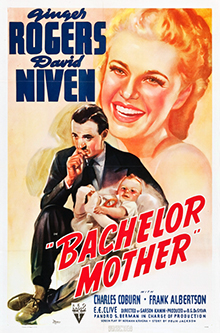
Bachelor Mother (1939) is an American romantic comedy film directed by Garson Kanin, and starring Ginger Rogers, David Niven, and Charles Coburn. The screenplay was written by Norman Krasna from an Academy Award-nominated story by Felix Jackson written for the 1935 Austrian-Hungarian film Little Mother. With a plot full of mistaken identities, Bachelor Mother is a light-hearted treatment of the otherwise serious issues of child abandonment.
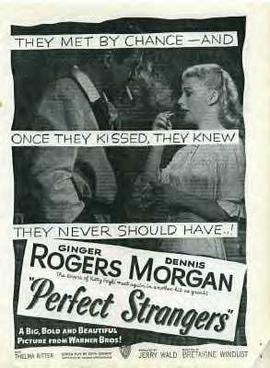
Perfect Strangers, also released as Too Dangerous to Love in some territories, is a 1950 American comedy-drama film directed by Bretaigne Windust. Edith Sommer wrote the screenplay from an adaptation written by George Oppenheimer, based on the 1939 play Ladies and Gentlemen by Charles MacArthur and Ben Hecht. The film stars Ginger Rogers and Dennis Morgan as two jurors who fall in love while sequestered during a murder trial. Thelma Ritter, Margalo Gillmore, and Anthony Ross co-star in supporting roles.

James Craig was an American actor. He is best known for appearances in films like Kitty Foyle (1940) and The Devil and Daniel Webster (1941), and his stint as a leading man at Metro-Goldwyn-Mayer in the 1940s where he appeared in films like The Human Comedy (1943).

John Elmer Carson, known as Jack Carson, was a Canadian-born American film actor. Carson often played the role of comedic friend in films of the 1940s and 1950s, including The Strawberry Blonde (1941) with James Cagney and Arsenic and Old Lace (1944) with Cary Grant. He appeared in such dramas as Mildred Pierce (1945), A Star is Born (1954), and Cat on a Hot Tin Roof (1958). He worked for RKO and MGM, but most of his notable work was for Warner Bros.
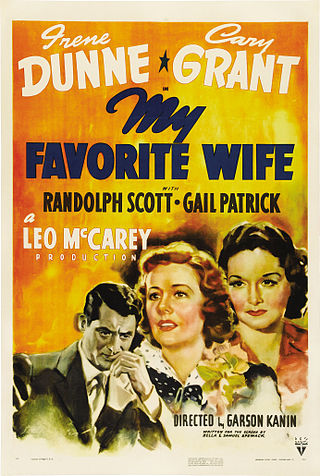
My Favorite Wife, released in the United Kingdom as My Favourite Wife, is a 1940 screwball comedy produced by Leo McCarey and directed by Garson Kanin.

Dennis Morgan was an American actor-singer. He used the acting pseudonym Richard Stanley before adopting the name under which he gained his greatest fame.

Vivacious Lady is a 1938 American black-and-white romantic comedy film directed by George Stevens and starring Ginger Rogers and James Stewart. It was released by RKO Radio Pictures. The screenplay was written by P.J. Wolfson and Ernest Pagano and adapted from a short story by I. A. R. Wylie. The music score was by Roy Webb and the cinematography by Robert De Grasse.

Renié Conley was a prominent Hollywood costume designer.

Kitty Foyle is a 1939 American novel by Christopher Morley. A bestseller in 1939 and 1940, it was adapted as a popular 1940 film, and was republished during World War II as an Armed Services Edition.

Tom, Dick and Harry is a 1941 comedy film directed by Garson Kanin, written by Paul Jarrico, and starring Ginger Rogers, George Murphy, Alan Marshal, Phil Silvers, and Burgess Meredith. It was released by RKO Radio Pictures.

Fifth Avenue Girl, sometimes stylized as 5th Ave Girl, is a 1939 RKO Radio Pictures comedy film directed by Gregory La Cava and starring Ginger Rogers, Walter Connolly, Verree Teasdale, and James Ellison. The screenplay was written by Allan Scott with uncredited contributions by La Cava and Morris Ryskind.
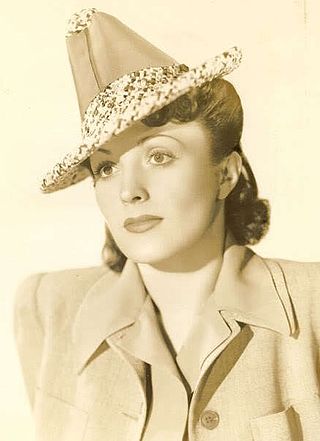
Mary Katherine Linaker was an American actress and screenwriter who appeared in many B movies during the 1930s and 1940s, most notably Kitty Foyle (1940) starring Ginger Rogers. Linaker used her married name, Kate Phillips, as a screenwriter, notably for the cult movie hit The Blob (1958). She is credited with coining the name "The Blob" for the movie, which was originally titled "The Molten Meteor".
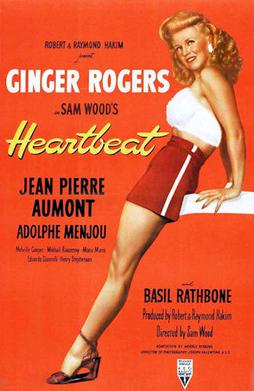
Heartbeat is a 1946 American romantic comedy drama film directed by Sam Wood and starring Ginger Rogers, Jean-Pierre Aumont, Adolphe Menjou and Basil Rathbone. It is a direct remake of the French romantic drama Battement de cœur, released in 1940. It was produced by the Hakim Brothers for distribution by RKO Pictures.
Mel Berns was an American make-up artist. He was the Head of Makeup at RKO Pictures for more than twenty years.

Fred Astaire and Ginger Rogers were dance partners in a total of 10 films, nine of them released by RKO Radio Pictures from 1933 to 1939, and one, The Barkleys of Broadway, by Metro-Goldwyn-Mayer in 1949, their only film in Technicolor.

Odette Myrtil was a French-born American actress, singer, and violinist. She began her career as a violinist on the vaudeville stage in Paris at 14. She expanded into acting and singing and had her first major success at 18 on the London stage in the 1916 musical revue The Bing Boys Are Here. She was a staple in Broadway productions from 1924 to 1932, after which she returned only periodically to Broadway through 1960. She also appeared on the stages of Chicago, London, Los Angeles, and Paris several times during her career.
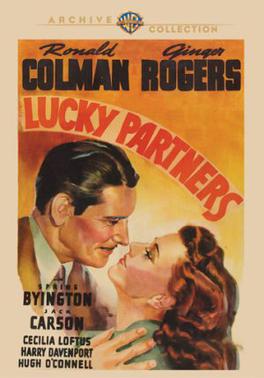
Lucky Partners is a 1940 American romantic comedy film starring Ronald Colman and Ginger Rogers. Directed by Lewis Milestone for RKO Radio Pictures, it is based on the 1935 Sacha Guitry film Good Luck. The picture was the only film pairing of Colman and Rogers, and Rogers' eleventh and final film written by Allan Scott.
Kitty Foyle is an American old-time radio and television soap opera originally aired during the 1940s and 1950s that was based on the 1940 film of the same name starring Ginger Rogers. Kitty Foyle was created by soap opera mogul Irna Phillips of Guiding Light fame and produced by daytime radio monarchs Frank and Anne Hummert of Helen Trent recognition. The program originally starred Julie Stevens in the title role of Kitty Foyle on radio. On television, the title role was portrayed by Kathleen Murray.

The Ginger Rogers filmography lists the film appearances of American actress Ginger Rogers, as well as her television, stage, and radio credits. Rogers's career spanned fifty-seven years, from 1930 to 1987.




















